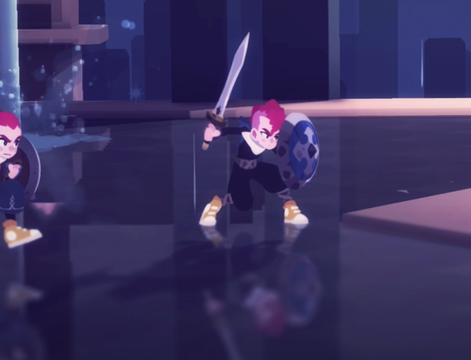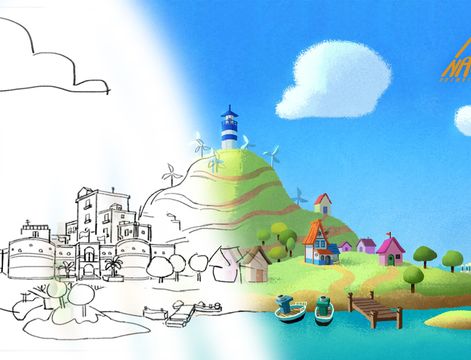
Some of ALICE's achievements so far
Final Partner meeting of July 1 2002
ALICE explores avenues for interregional collaborations in the animation sector to leverage the sector's potential for growth and innovation and to foster the development of a pan-European, world-leading industry.
The booming animation sector creates new economic opportunities, which were set out by the European Animation Plan launched on 12 September 2017 whose priorities are expected to be implemented during the new Creative Europe MEDIA programme (2021-2027). ALICE intends to unlock these opportunities and study ways of facilitating interregional co-productions, promoting training and creating jobs.
Over the past five years, several animation studios capable of competing in the global marketplace have emerged in Europe. Some European productions funded by regional funds, such as ‘My Life as a Courgette’ and ‘The Red Turtle’, were nominated for the Oscars. Others, like ‘Sammy’s Adventures 1 & 2’, Paddington’ and ‘Tarzan’ drew over 5 million viewers globally, and European TV series have not been left behind.
In the meantime, digitization and changing consumption habits (using tablets, smartphones, internet, mobile and web applications) have massively disrupted the market and the way audiences (especially youth) consume content. New SMEs in Europe are holding high added-value intellectual properties, craved for by streaming platforms.
To position the European animation industry on the global scene, it is essential to value our assets, tap into all of our resources and capitalize on synergies. ALICE plans to make its partner regions the drivers for realizing this potential.
To achieve this objective, ALICE will study options leading to:
- Improve the current policy instruments to foster the development of financial instruments that can scale up activities of SMEs in the sector;
- Suggest ways to train (through public and private partnerships) and retain talented animators by changing the eligibility rules of existing or soon to be created support funds;
- Identify innovative methods for distributing animated content;
- Examine the possibility of grouping SMEs together into clusters to help them internationalize.
€1,144,715.00
SME competitiveness
TO3 – aims to strengthen the competitiveness of Walloon businesses and improve work productivity (differentiation by quality) – PI TO3c improve SME competitiveness by supporting the creation and expansion of high-tech capacities with a view to developing products and services – Measure 1.2.1 Advanced support service for SMEs – proactive economy.
Wallonia is facing a high number of business failures that is only just being counterbalanced by new businesses being set up. Having a source of SMEs active in high-tech sectors, financially sound and ready to embark on a growth phase is therefore one of the objectives identified in this policy instrument. This measure notably aims to encourage entrepreneurship, by facilitating the economic exploitation of new ideas, by supporting the creation of new businesses, etc. More than a reactive approach, a proactive step has to be taken in terms of target businesses, the most likely to turn public support into a contribution to the overall objectives of creating added value, growth and jobs.
This is the context that SMEs active in the animation sector are operating in. They use innovative technologies and creativity, and need international markets so that they can expand. Once in hand, the value chain of the animation sector leads to the creation of high added value intellectual property rights. The adaptation of the instrument should look to adapt its means of intervention in favour of the SMEs active in this sector.
Pictanovo’s actions to help and finance animation started in the 2010s. In 2018, Pictanovo structured a fund entirely dedicated to this specific field to address its particular aspects and issues: animation projects are much longer (4 to 8 times) and more expensive (for a mid-budget film, at least twice as expensive) than live projects. Four times a year, a call for projects is published on Pictanovo’s website. Production companies respond to these, asking for up to €330 000 to help carry out their animation projects. To be eligible, projects have to meet administrative and legal criteria. They are then forwarded to a committee composed of independent professionals from the sector who meet three times a year to evaluate all files from an artistic and financial point of view. Pictanovo thus becomes a co-producer of the projects selected. To this day, Pictanovo has helped more than 50 projects through its animation fund.
But Pictanovo still has difficulty attracting projects and companies, and needs to create a virtuous circle involving companies and talented professionals. Part of the reason is that once those professionals finish their studies in Hauts-de-France they leave for Canada, the US or Japan because of a lack of long-term projects and job security. As a result, this policy instrument needs to be improved in order to increase the number of European co-productions.
Investment Priority 3.4: Support the capacity of SMEs to grow in regional, national and international markets and innovation processes.
Specific Objective 3.4.1: Promoting the growth and consolidation of SMEs, in particular by improving their financing, technology and access to advanced support services.
This instrument includes the support for and promotion of SME innovation (both technological and non-technological) through different financing formulae (as international cooperation agreements or other new forms that facilitate access to finance). As the animation sector is at a junction point between technological and creative innovation, a financial instrument specifically dedicated to this growing sector could be put in place to raise funds to create high-value Intellectual Property Rights (IPR).
As this industry must deal with complex innovation processes as well as the need to reach international markets through cooperation with similar entities, an alignment with the RIS3CAT strategy (objectives of improving innovation and the internationalisation of companies and promoting job creation) seems necessary.
The Capital barrier is a key factor in terms of enabling SMEs to resize, internationalise and adopt innovations. The animation sector should be recognised as a significant player among the CCI industries and benefit from special measures taken in this area to improve their competitiveness and strengthen their international expansion.
Thematic Objective 3; Investment Priority 3.b) Develop and implement new business models for SMEs, especially for internationalisation, Specific Objective: RA 3.3 Consolidate, modernise and diversify the local production systems, Action 3.4 Support for SMEs in the cultural, touristic, creative and performing arts.
Until now, the work carried out to draw attention to the cultural sectors has not taken into account the CCIs’ strategic sectors, such as animation and video games.
This work (measure) does not currently include arranging interventions, despite the need for them, such as granting greater economic and financial independence to businesses in the sector, something that would enable the introduction of more effective management methods. This would see a better inter-generational exchange regarding management methods and the repositioning of activities in the market as well as their revival and diversification (as seen in a 2015-2016 survey conducted among those involved with cultural and creative operators in the region).
Such an intervention would serve to improve the sector’s ability to compete in the international market.
Priority I - COMPETITIVE AND INNOVATIVE ECONOMY.
Specific objective: Promoting entrepreneurship, in particular by facilitating the economic use of new ideas and fostering the creation of new businesses i.e. through business incubators.
This objective is oriented towards support provided for business networking through the creation and development of initiatives contributing to strengthening the competitiveness of SMEs actively participating in cooperation networks and strengthening their position.
This priority is also aimed at creating appropriate conditions for development of the region's economy by supporting business and academic incubators, helping enterprises incubated to access services, and implementing a project to help enterprises incubated from RIS3 to finance the purchase of services.
The aim of the priority is also to achieve better conditions for the development of enterprises by providing them with access to professional business-related services.
Podkarpackie is one of the regions with the lowest level of economic development. The number of specialists educated and working in the IT sector (including animation) is growing, however many of them leave the region and/or the country looking for better salaries and development opportunities.
"ICT and telecommunication", indicated as a smart supporting specialisation in the RIS3, is described as a horizontal area that is important in each specialisation and sphere of life in the region.
The Strategy as such covers the topic of CCIs as a multisector with its mutual features and needs, and thus does not address the specific features of the animation industry from a sector point of view. According to the growth potential identified in the Animation Plan for Europe and also the current state-of-play in the Slovak animation industry, it is necessary to set up new measures addressing the specific needs of this sector. According to statistical data available from 2017, the annual turnover of the animation industry and gaming industry is approximately 40 million euro. The Action Plan will enable the growth and development of the industry. The Strategy itself and all current and future Action Plans are based on the Manifesto of the Slovak Government: “In order to prepare and implement system-level and beneficial measures in the field of culture, the Government will continue an effective dialogue with experts on culture, local government representatives and other relevant stakeholders... At the same time, the Government will prepare new strategic documents, projects and action plans for the main cultural domains for the coming years... The Government will follow up and continue the changes in the funding of culture, gradually moving away from direct support from the State towards funding from public funds and local authorities."

Final Partner meeting of July 1 2002

This is the story of ALICE hosting a warm and enlightening hybrid event at Annecy's animated film market MIFA after months of COVID hardship.

Coming this fall: a full set of solutions for a strong, competitive and sustainable animation industry of Europe.

ALICE presents its new tools for a strong animation network and co-development of European projects.

ALICE's new mapping methodology is now available for use, anywhere in Europe.

ALICE to present selected proposals at Annecy International Animation Film Festival’s Market on June 17.

Wallimage uses video to unite animation industries across Europe around the Wonderland concept.

Pictanovo learns from ALICE how to better communicate with gaming companies.

Creating European training programs in animation based on a common understanding of jobs key skills and duties: the Apulia region takes up the challenge!

Animation producer Pablo Jordi calls on his peers to push for a reform of the financing system and build a strong animation with the young generation.